WP Toolkit
WP Toolkit
Summary: WP Toolkit is a single management interface you can use to create, configure, and manage WordPress websites in Plesk.
In this topic, you will learn how to install WordPress on websites in Plesk and how to register existing WordPress websites in WP Toolkit. You will also learn how to automatically pre-install WordPress on newly created websites, how to create and manage sets of WordPress plugins and themes, how to install plugins and themes on or remove them from WordPress websites, how to back up and restore WordPress websites, and also how to configure a variety of WordPress settings, such as the default database table prefix.
Note: WP Toolkit can install, configure, and manage WordPress version 4.9 or later.
Prerequisites
Before you can start using WP Toolkit, the WP Toolkit extension must be installed on the Plesk server:
- If you are the Plesk administrator, install the extension from the Extensions Catalog.
- Otherwise, contact your hosting provider and ask them to install the extension for you.
Once the extension is installed, you are ready to begin. You will see the WordPress option in the Navigation Pane.
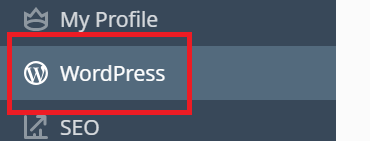
The “WordPress” option will also appear in domains’ Create Website drawers.
Note: The WP Toolkit extension is free with the Web Pro and the Web Host Plesk editions and is available for a fee for the Web Admin edition.
Installing WordPress
To install a new WordPress installation, go to WordPress and click Install.

Here you can:
-
Install the latest version of WordPress with the default settings by clicking Install.
-
Change the default settings (including the desired WordPress version, the database name, the autoupdate settings, and more) and then click Install.
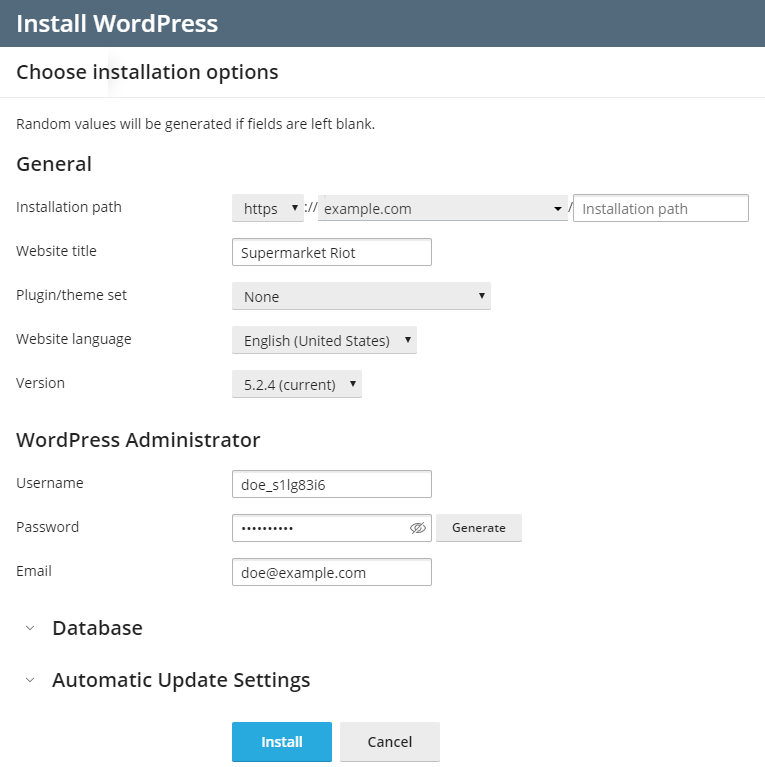
Note: To install WordPress, WP Toolkit retrieves data from wordpress.org. By default, if WP Toolkit cannot establish connection in 15 seconds, wordpress.org is considered to be unavailable. If you experience connectivity issues (for example, due to the poor quality of the Internet connection), consider increasing the timeout value. To do so, go to WordPress, click “Settings”, specify the desired value in the “HTTP timeout for retrieving data from wordpress.org (sec)” field, and then click OK.
WordPress is now installed. You can find the new installation in the list of existing WordPress installations in WordPress.
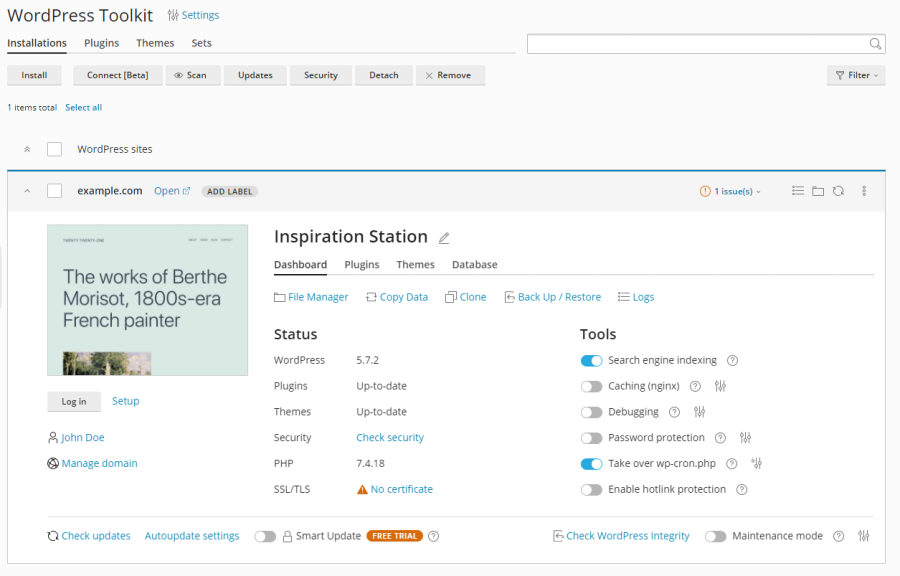
Adding Existing WordPress Installations to WP Toolkit
All WordPress installations added using WP Toolkit appear in WP Toolkit automatically. Those installed manually need to be attached to WP Toolkit. If you have upgraded from an earlier version of Plesk and you used WordPress, we recommend that you attach all existing WordPress installations to WP Toolkit.
To attach WordPress installations to WP Toolkit:
- Go to WordPress.
- Click Scan.
The WordPress installation is now attached. You can find it in the list of existing WordPress installations in WordPress.
Importing WordPress Installations
You can use the “Web Site Migration” feature to migrate WordPress websites owned by you but hosted elsewhere to Plesk. When you migrate a WordPress website, Plesk copies all its files and the database to your server. Once a website has been migrated, you can manage it using WP Toolkit.
Learn how to migrate an existing WordPress website.
Selecting One Language for All WordPress Installations on the Server
When WordPress is installed via WP Toolkit, WP Toolkit selects the default WordPress language that matches the Plesk interface language of the user for whom WordPress is installed. For example, if you have a user whose Plesk interface language is Italian and you install WordPress for this user, Italian will be selected as the default WordPress language.
However, you may want to have one language for all WordPress installations on the server regardless of Plesk interface languages selected by users. To do so, go to WordPress > Settings, select the default WordPress installation language, and then click Save. The selected language will be the default one for all new WordPress installations on the server. Users remain free to choose a different language when they install WordPress if they want.
To return to the default way of selecting the WordPress language, go to WordPress > Settings, select “Same as user language” next to “Default WordPress installation language”, and then click Save.
Specifying One Database Table Prefix for All WordPress Installations on the Server
WP Toolkit generates random prefixes of the database tables for each new WordPress installation on your Plesk server. You may want to change this behavior and specify one default prefix that all new WordPress installations will use.
To specify the default prefix of the database tables:
-
Go to WordPress > Settings.
-
Next to “Default database table name prefix”, specify the desired prefix and then click Save.
Note: If you want to specify the
wp_prefix, change it a bit (for example,wporwp__). Thewp_prefix is considered insecure and conflicts with WP Toolkit security measures. If you specify this prefix, new WordPress installations will receive the “Danger” security status. Any form different from the exactwp_does not trigger the security warning.
To return to random prefixes, clear the “Default database table name prefix” field and then click Save.
Preinstalling WordPress on Users’ Domains
Watch the video tutorial
With Plesk WP Toolkit, you can have WordPress preinstalled on newly created domains. You can have predefined lists of plugins and themes installed on those domains. In addition, you can give your customers and resellers the ability to enable Smart Updates.
For every hosting plan, you can choose among the following options:
- Do not preinstall WordPress.
- Preinstall WordPress only.
- Preinstall WordPress with a predefined set of plugins and themes.
- Preinstall WordPress with or without a predefined set of plugins and themes and give ability to enable Smart Updates.
If you choose any of the last three options, WordPress will be automatically installed on the first domain of every subscription based on the hosting plan (main domain).
To preinstall WordPress on newly created domains:
- Go to Service Plans.
- On the “Hosting Plans” tab, either click Add a Plan to create a new plan, or click the name of an existing plan to edit it.
- If you have installed the Smart Updates license, customers and resellers can also enable Smart Update. You can specify the exact number of customers’ and resellers’ installations that can use Smart Update. To do so, clear the “Unlimited” checkbox next to “WordPress websites with Smart Update” and specify the desired limit. Regardless of the specified number, customers and resellers cannot use Smart Update on more WordPress installations than your Smart Updates license allows.
- Go to the “Additional Services” tab.
- Choose whether to preinstall WordPress only or WordPress with a predefined set of plugins and themes:
- To install WordPress only, select “Install WordPress” under “WP Toolkit”.
- To install WordPress with a predefined set of plugins and themes, select “Install WordPress with the … set” under “WP Toolkit”.
- Click OK (or Update & Sync if editing an existing plan).
Now every time you create a new subscription based on this hosting plan, WordPress will be installed automatically on that subscription’s main domain. Existing subscriptions based on this hosting plan will not be affected.
Managing Sets
A set is a predefined list of WordPress plugins and themes. WP Toolkit comes with a number of preconfigured sets, and you can always create more. By default, every set you create becomes available to customers and resellers. You can use sets in the following ways:
-
You can preinstall sets on customers’ and resellers’ websites. To do so, configure a hosting plan to preinstall WordPress and choose to add a single set. When you do this, all plugins and themes included in the set will be installed together with WordPress.
-
You as well as your customers and resellers can select a set to install it together with WordPress when performing a custom installation. Customers and resellers can see which plugins and themes are included in a set.
Note: If you do not want customers and resellers to install sets on their WordPress installations, go to WordPress, click “Settings”, and clear the “Allow customers to use sets when they install WordPress” checkbox.
-
You can install sets on already existing websites that belong to you or your customers and resellers.
To create a set:
-
Go to WordPress, go to the “Sets” tab, and then click Create Set.
-
Give your set a name and click Create.
-
Click “Add Plugins”, and then click Add Plugin. Search for the desired plugin, select it from the list, and then click Add.
Note: You can choose which plugins to activate and which not to once the set is installed on a WordPress website. To do so, under the “State” column, turn off plugins you do not want to activate.

When you have added all desired plugins, close the pane.
-
Repeat the previous step for themes.
Note: You can choose which theme to activate once the set is installed on a WordPress website. To do so, under the “State” column, turn on the theme you want to activate.
Now you can select the set as a preinstallation option in the hosting plan or during custom installation of WordPress.
To add plugins and themes to a set:
-
Go to WordPress, and then go to the “Sets” tab.
-
Click “Add Plugins” for the set you want to modify, and then click Add Plugin. Search for the desired plugin, select it from the list, and then click Add.
Note: You can choose which plugins to activate and which not to once the set is installed on a WordPress website. To do so, under the “Active” column, turn off plugins you do not want to activate.
When you have added all desired plugins, close the pane.
-
Repeat the previous step for themes.
Note: You can choose which theme to activate once the set is installed on a WordPress website. To do so, under the “Active” column, turn on the theme you want to activate.
Adding plugins and themes to a set does not affect existing subscriptions to which this set has been applied.
To install a set on existing WordPress installations:
- Go to WordPress, go to the “Sets” tab, and then click the
 icon corresponding to the set that you want to install.
icon corresponding to the set that you want to install. - Click Install Set, select websites on which you want to install the set, and then click Install.
The set will be installed on the selected WordPress installations. The plugins and theme in the set will be activated if you chose them to be when you created the set.
To remove the selected plugins and themes from a set:
- Go to WordPress, and then go to the “Sets” tab.
- Click the number displayed under the “Plugins” or “Themes” columns (for example,
2 total) to show the list of plugins or themes currently included in the set. - Click the
 icon next to the names of the plugins or themes you want to remove.
icon next to the names of the plugins or themes you want to remove.
To remove all plugins and themes from a set:
- Go to WordPress, and then go to the “Sets” tab.
- Click the
 icon corresponding to the set you want to modify, click either Remove All Plugins or Remove All Themes, and then click Yes.
icon corresponding to the set you want to modify, click either Remove All Plugins or Remove All Themes, and then click Yes.
Removing plugins and themes from a set does not affect existing subscriptions to which this set has been applied.
To rename a set:
- Go to WordPress, and then go to the “Sets” tab.
- Click the name of the set you want to rename, type a new name, and then click the
 icon.
icon.
To remove a set:
-
Go to WordPress, and then go to the “Sets” tab.
-
Click the
 icon corresponding to the set you want to remove, click Remove Set, and then click Yes.
icon corresponding to the set you want to remove, click Remove Set, and then click Yes.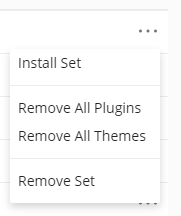
Removing a set does not affect existing subscriptions to which this set has been applied. For all hosting plans that used the removed set, WordPress preinstall settings are reset (on the “Additional Services” tab, “WP Toolkit” is set to “None”).
Limiting the Number of Users’ WordPress Installations
The Plesk administrator can set a limit on the number of WordPress installations customers and resellers can install and manage. The limit relates to the following ways of increasing the number of WordPress installations:
- Installing WordPress websites via WP Toolkit.
- Adding existing WordPress installations using the “Scan” feature.
- Cloning WordPress installations.
Note: Technical installations that WP Toolkit creates itself (for example, clones made by Smart Updates) do not count towards the limit.
To set a limit on the number of WordPress installations:
-
You can set a limit in a particular subscription or in a service plan:
- Go to Subscriptions, and either click Add Subscription to create a new subscription or click the name of an existing subscription and then click Customize in the right sidebar.
- Go to Service Plans. On the “Hosting Plans” tab, either click Add a Plan to create a new plan or click the name of an existing plan to edit it.
-
By default, no limits are set. Next to “WordPress Websites”, clear the “Unlimited” checkbox. You can also limit the number of WordPress websites that can use the “Smart Updates” feature. If so, clear the checkbox next to “WordPress websites with Smart Update” as well.
-
Specify the number of WordPress websites customers can manage and/or the number of WordPress websites that can use the “Smart Updates” feature.

-
Click OK (or Update & Sync if editing an existing plan).
You have set up a limit on the number of users’ WordPress installations.
Note: If you set up a limit lower than the number of websites a customer has, it will not automatically delete redundant installations. The number of the user’s existing installations remains unchanged unless the user removes or detaches some. Then it will not be possible to bring these installations back or to increase the number of installations in any other way beyond the limit.
Limiting the Number of Users’ WP Toolkit Backups
The Plesk administrator can set a limit on the number of WP Toolkit backups customers and resellers can create.
This limit prevents customers and resellers from using up allowed disk space quota. The limit is applied to each website belonging to a subscription. To make WP Toolkit backups unavailable to users, set the limit to zero.
To set a limit on the number of WP Toolkit backups:
-
You can set a limit in a particular subscription or in a service plan:
- Go to Subscriptions, and either click Add Subscription to create a new subscription or click the name of an existing subscription and then click Customize in the right sidebar.
- Go to Service Plans. On the “Hosting Plans” tab, either click Add a Plan to create a new plan or click the name of an existing plan to edit it.
-
By default, no limits are set. Next to “WordPress Backups”, clear the “Unlimited” checkbox and then specify the number of backups customers and resellers can create.

-
Click OK (or Update & Sync if editing an existing plan).
You have set up a limit on the number of users’ WP Toolkit backups.
Note: If you set up a limit lower than the number of backups a user has, it will not automatically delete redundant backups. The number of the user’s existing backups remains unchanged unless the user removes some. Then it will not be possible to create backups beyond the limit.
Managing WordPress Installations
Go to WordPress to see all WordPress installations hosted on the server.
WP Toolkit groups information about each installation in blocks we call cards.

A card shows a screenshot of your website and features a number of controls that give you easy access to frequently used tools. The screenshot changes in real time to reflect the changes you make to your website. For example, if you turn on maintenance mode or change the WordPress theme, the screenshot of the website will change immediately.
Note: Changes you make directly in WordPress are synchronized with WP Toolkit once every 24 hours. To sync manually, click the  icon.
icon.
When you move the mouse cursor over the screenshot of the website, you’ll see the following:
- Open Website button. To open the website in a new browser tab, click the button.
- Date and time the screenshot was updated last time. To update the screenshot right away, in the upper-right corner of the screenshot, click the
 icon.
icon.
Here you can also do the following:
-
Change your website name. To do so, click the
 icon, give your website a name, and then click
icon, give your website a name, and then click  .
.
-
Log in to WordPress as an administrator. To do so, click Log in below the website screenshot.
-
Change general WordPress settings. To do so, click “Setup” next to Log in.
-
Go to the domain’s screen in Websites & Domains. To do so, click Manage domain below the website screenshot.
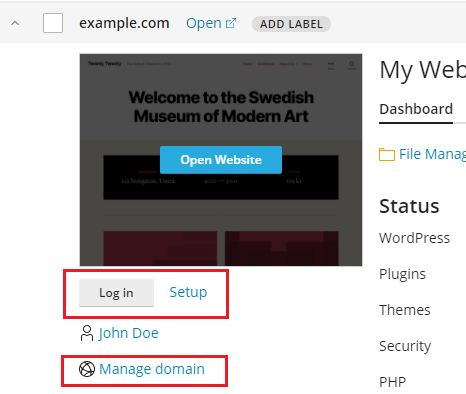
Status
WordPress websites are frequently targeted by hackers. Outdated WordPress core, plugins, and themes also pose a security risk.
In the “Status” section, you can do the following:
- See if the WordPress core as well as installed plugins and themes are up to date and update them if necessary.
- See if SSL/TLS support is enabled and, if not, enable it.
- See how safe is your website and enhance its security.
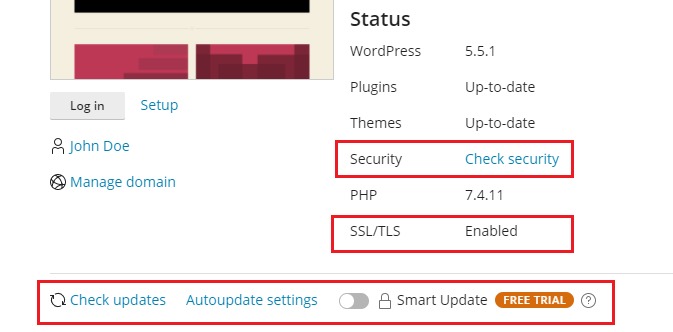
The controls in the “Tools” section give you easy access to the following settings and tools:
- “Search engine indexing” shows your website in search results of search engines.
- “Caching (nginx)” speeds up the website load time and reduces server load.
- “Debugging” helps you debug a website that is not ready for viewing and being tested or developed.
- “Password Protection” specifies the password you will use to log in to WordPress from Plesk.
- “Take over wp-cron.php” helps you set up a regular run of
wp-cron.php. - Enable hotlink protection helps you prevent other websites from displaying, linking or embedding your images. This is called hotlinking and it can quickly drain your bandwidth and make your website unavailable.
Above the “Status” and “Tools” sections, you find the following WP Toolkit features:

- “File Manager” to manage the website’s files in File Manager.
- “Copy Data” to copy the content of your website to another.
- “Clone” to make a full copy of your website.
- “Back Up / Restore” to create a backup of your website and restore it if necessary.
- “Logs” to view WP Toolkit logs of the installation you need to troubleshoot.
At the bottom of the website card, you can do the following:
-
Enable Smart Update, a premium feature, which helps you keep your production websites up to date without the risk of breaking them.
-
Turn on “Maintenance mode”, which hides your website’s content from visitors.

On the remaining three tabs you can manage the installation’s plugins, themes, and change the database username and password.
Website Labels
Website labels are preconfigured identifiers that you can give to your websites (for example, “staging”, “production”, “testing”, and so on).
Depending on your project, it might be necessary to host multiple copies of a website for various purposes. Labels will help you distinguish one website from another.
By default, a website has no label. To label it, click ADD LABEL (on the website card next to the website name) and select the desired label. Labels are optional and you can change or remove a label at any time.

Managing Cards View
You can choose the way WP Toolkit shows cards. The default view is best suited for a small number of installations. If you have a large number of installations, collapse cards ![]() .
.
You can also Filter installations to manage them easier.
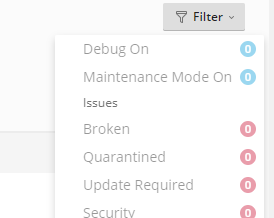
Removing and Detaching Installations
You can detach WordPress installations that you do not want to see and manage in WP Toolkit. Detaching does not remove the installation, merely hides it from WP Toolkit. A detached installation will be attached to WP Toolkit again after you scan for WordPress installations. You can detach WordPress installations individually or multiple installations at a time.
To detach WordPress installations:
- Go to WordPress and then do the following:
- (To detach an individual installation) On the card of the installation you want to detach, click the
 icon.
icon. - (To detach multiple installations) Select installations you want to detach and click Detach.
- (To detach an individual installation) On the card of the installation you want to detach, click the
- Click Detach.
Unlike detaching, removal completely deletes a WordPress installation. You can remove any installation, no matter how it was installed: using WP Toolkit, through the Applications page, or manually. You can remove WordPress installations individually or multiple installations at a time.
To remove WordPress installations:
- Go to WordPress and then do the following:
- (To remove an individual installation) On the card of the installation you want to remove, click the
 icon.
icon. - (To remove multiple installations) Select installations you want to remove and click Remove.
- (To remove an individual installation) On the card of the installation you want to remove, click the
- Click Remove.
Search Engine Indexing and Debugging
By default, a newly created WP Toolkit website is shown in search results of search engines. If your website is not yet ready for public viewing, turn off “Search engine indexing”.
If you are installing WordPress for testing or development, you can enable “Debugging” to automatically find and fix errors in the website code. To do so, click the ![]() icon next to “Debugging”, select the WordPress debugging tools you want to activate, and then click OK.
icon next to “Debugging”, select the WordPress debugging tools you want to activate, and then click OK.
Updating WordPress Installations
To keep your website secure, you need to regularly update the WordPress core, as well as any installed plugins and themes. You can do this either automatically or manually:
- Manual updates give you control over when updates are installed. For example, you can wait and see if installing a particular update caused issues for other WordPress users. However, you need to remember to update regularly to avoid falling behind.
- Autoupdates give you peace of mind by keeping your WordPress installation up to date. However, updates can sometimes break your installation, and with autoupdates, you may not learn about it right away.
For security reasons, we recommend that you configure autoupdates.
To update a WordPress installation manually:
-
Go to WordPress. If your WordPress installation needs updating, you will see the corresponding messages in the “Status” section (for example, “Install plugin updates”).
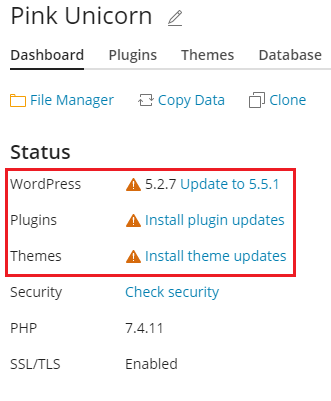
-
Click any message about available updates, wait for WP Toolkit to load the list of available updates, and then select the updates you want to install.
Note: If an update of a WordPress core is available, you will see the “Restore Point” checkbox. Keep this checkbox selected to create a restore point you can use to roll back the update if something goes wrong.
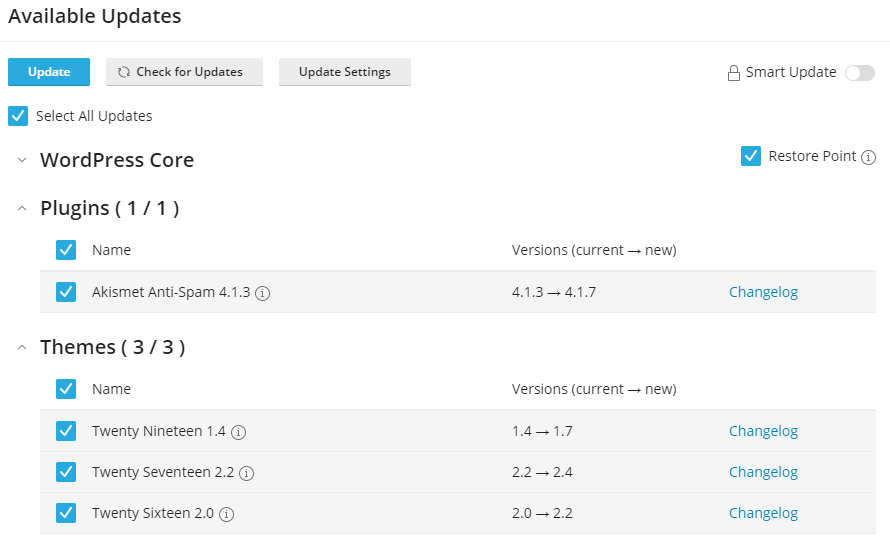
-
Click Update.
The selected updates will be applied.
Although WP Toolkit regularly checks for updates itself, you can also check for updates at any time. To do so, click “Check updates”.
To configure autoupdates for a WordPress installation:
-
Go to WordPress and choose the WordPress installation that you want to update automatically and then, on the installation card, click “Autoupdate settings”.

-
Choose the desired autoupdate settings.
You can configure autoupdates separately for WordPress core, plugins, and themes (for example, you can choose to enable autoupdates for plugins and themes, but not for WordPress core).
You can also configure autoupdates for all plugins and themes or individually for each plugin and theme.
To fine-tune autoupdates, follow these recommendations:
-
Selecting “No” next to “Update WordPress automatically” turns off autoupdates of WordPress core. This is insecure.
-
If your website is publicly available (production) and you are concerned that applying updates automatically may break it, keep “Yes, but only minor (security) updates” selected.
-
If your website is a non-public (staging) version of a WordPress website, select “Yes, all (minor and major) updates”. This will keep your staging website up-to-date and ensure that, should an update break something, it happens to the staging website and not to the production one.
-
In most cases, we recommend that you select “Defined individually, but security updates are autoinstalled” for both plugins and themes. Then you will need to configure autoupdates individually for each plugin and theme on the “Plugins” and “Themes” tabs of the website card.

However, WP Toolkit will automatically install security updates for vulnerable plugins and themes even if autoupdates for them are turned off.
If you are afraid that security updates of plugins can break your website, select the “Deactivate vulnerable plugins instead of updating them” checkbox. Then you can manually update vulnerable plugins and activate them again (when you are sure they are safe for your website).
To save effort in turning on autoupdates for each new plugin and theme on the “Plugins” and “Themes” tab, select “Enable autoupdates by default for new plugins installed via WP Toolkit” and “Enable autoupdates by default for new themes installed via WP Toolkit”.

-
To have more control over autoupdates, select “Defined individually” for plugins and themes. This scenario is very similar to the previous one but WP Toolkit will not update a vulnerable plugin or theme if autoupdates for it are turned off. We recommend that you monitor WP Toolkit email notifications of vulnerable plugins and themes and manually update or deactivate them.
-
To make sure all plugins and themes are always up to date, select “Forced” for both plugins and themes. In this case, WP Toolkit will automatically update all plugins and themes regardless of their individual autoupdate settings. Selecting the “Forced” option overrides individual autoupdate settings of plugins and themes shown on the “Plugins” and “Themes” tabs.
-
-
Click OK.
Note: If you are concerned that WordPress autoupdates may break your website, use Smart Updates. With Smart Updates, WordPress installations are always updated safely without breaking your website. When you enable Smart Updates, they will check all autoupdates and allow only those that cause no issues for your website.
Backing up and Restoring WordPress Installations
To help prevent data loss, you can back up and restore websites. To do so, you can use either the WP Toolkit feature or the general Plesk backup mechanism, called Backup Manager.
Creating backups in WP Toolkit may be more convenient than in Backup Manager because of the following reasons:
- WP Toolkit backs up an individual website, while Backup Manager backs up the whole subscription with all the subscription’s websites and their data.
- If you need to back up an individual website, a WP Toolkit backup requires less time and disk space.
- Creating backups in WP Toolkit does not require any setup.
To back up a WordPress website:
-
Go to WordPress and then click Back up / Restore on the card of the WordPress installation you want to back up.

-
Click Back up.
Once the backup is finished, it will be displayed in the list of WP Toolkit backups.

To restore a WordPress website:
-
Go to WordPress and then click Back up / Restore on the card of the WordPress installation whose backup you want to restore.
-
Click the
 icon corresponding to the backup you want to restore.
icon corresponding to the backup you want to restore.Note: Restoring a backup removes all changes you made to the website after the backup date. For this reason, WP Toolkit suggests that you back up the current state of your website and use this backup to restore.
-
Click Restore.
You have restored your backup.
To be on the safe side, you may want to download WP Toolkit backup files to store them elsewhere.
To download WP Toolkit backup files:
-
Go to WordPress and then click Back up / Restore on the card of the WordPress installation whose backup files you want to download.
-
Click the
 icon corresponding to the backup whose file you want to download.
icon corresponding to the backup whose file you want to download.You will be redirected to the directory in File Manager (
/wordpress-backupsin the website’s home directory) where WP Toolkit backups are stored. -
Click the
 icon corresponding to the backup file you want to download and then click Download.
icon corresponding to the backup file you want to download and then click Download.
You have downloaded a backup file.
You can delete WP Toolkit backups you no longer need.
To delete a WP Toolkit backup:
- Go to WordPress and then click Back up/Restore on the card of the WordPress installation whose backup file you want to delete.
- Click the
 icon corresponding to the backup you want to delete and then click Delete.
icon corresponding to the backup you want to delete and then click Delete.
You have deleted a backup.
Smart Updates
Smart Updates is a premium feature included in WP Toolkit Deluxe or bought as a standalone extension. It helps you keep your production websites up to date without the risk of breaking your website. Smart Updates analyses the potential consequences of installing updates and advises you whether doing so is safe.
To keep your websites secure, you need to regularly update WordPress: themes, plugins, and core. However, these updates can potentially break you websites. Manual updates require your attention and cannot guarantee that your websites will continue working.
Smart Updates makes sure a WordPress installation is always updated safely without breaking your website. It does the following:
- Clones the installation and then analyses the clone for issues.
- Updates the clone and analyses it again.
- Detects issues (PHP issues, HTTP response code errors, changed page titles, and others): not only those the update can cause but also those that existed before the update.
- With manual updates, Smart Updates reports whether or not it is safe to update. You can view and download the detailed report about the issues found and then decide whether to update the production website or not.
- With autoupdates, Smart Updates automatically updates the production website unless there is at least one issue caused by the update. Otherwise the update is not performed and you receive an email with the results of the analysis.
Using Smart Updates
Smart Updates is a paid feature, which you buy on a per installation basis. You can use Smart Updates with both manual and autoupdates.
To enable Smart Update:
- Buy Smart Updates and install the received additional license key. You enable Smart Update separately for each installation.
- Go to WordPress and turn on “Smart Update” on the installation card.
You have enabled Smart Update. Now you can use it with manual or autoupdates.
Note: Smart Update is not an alternative to backups. We recommend that you regularly back up your WordPress installations especially if you use autoupdates.
To use Smart Update manually:
-
Make sure you have enough disk space for a full copy of the installation that you want to update.
-
On the installation card, click Updates.
<

